Capstone Project on Mobile Learning Benefits in K-12 Classrooms
VerifiedAdded on 2022/10/19
|34
|10148
|28
Capstone Project
AI Summary
This capstone project, undertaken at Thompson Rivers University, examines the benefits of mobile learning in K-12 classrooms within the Canadian education system. The author, drawing upon personal experience and research, argues that mobile learning, utilizing devices like tablets and smartphones, enhances student engagement and learning outcomes. The paper explores the flexibility, multiple device support, and interesting design formats offered by mobile learning. It contrasts the technology used in Indian and Canadian classrooms, highlighting the need for technological advancements in India. The project identifies challenges such as security, ethical issues, and funding, proposing recommendations to overcome them. The author concludes that integrating mobile learning is crucial for improving educational capabilities in K-12 schools, emphasizing its potential to save time, reduce costs, and provide personalized learning experiences. The project provides detailed literature review, application of the thesis to real-world context and discusses the broader implications of mobile learning adoption.
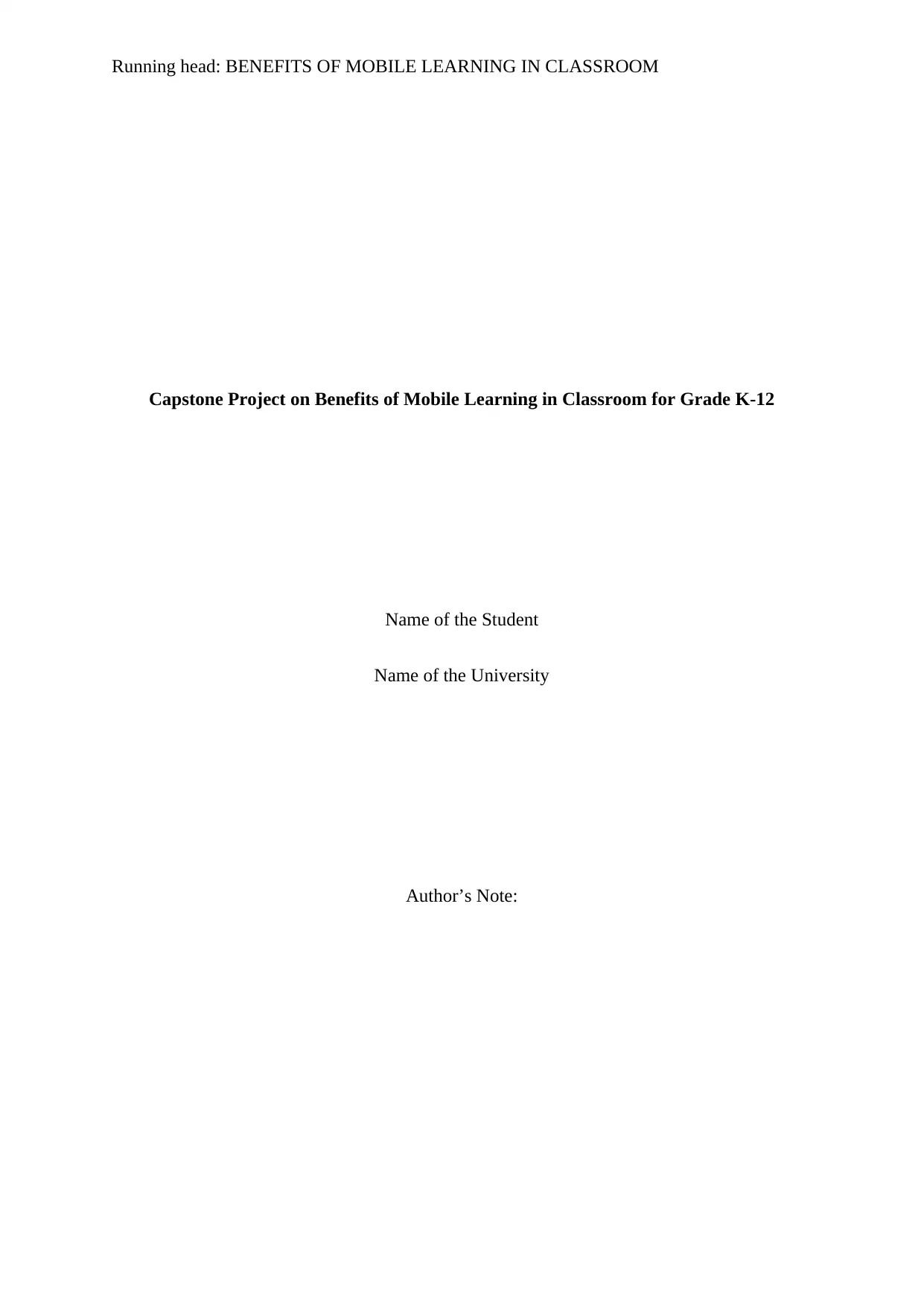
Running head: BENEFITS OF MOBILE LEARNING IN CLASSROOM
Capstone Project on Benefits of Mobile Learning in Classroom for Grade K-12
Name of the Student
Name of the University
Author’s Note:
Capstone Project on Benefits of Mobile Learning in Classroom for Grade K-12
Name of the Student
Name of the University
Author’s Note:
Paraphrase This Document
Need a fresh take? Get an instant paraphrase of this document with our AI Paraphraser
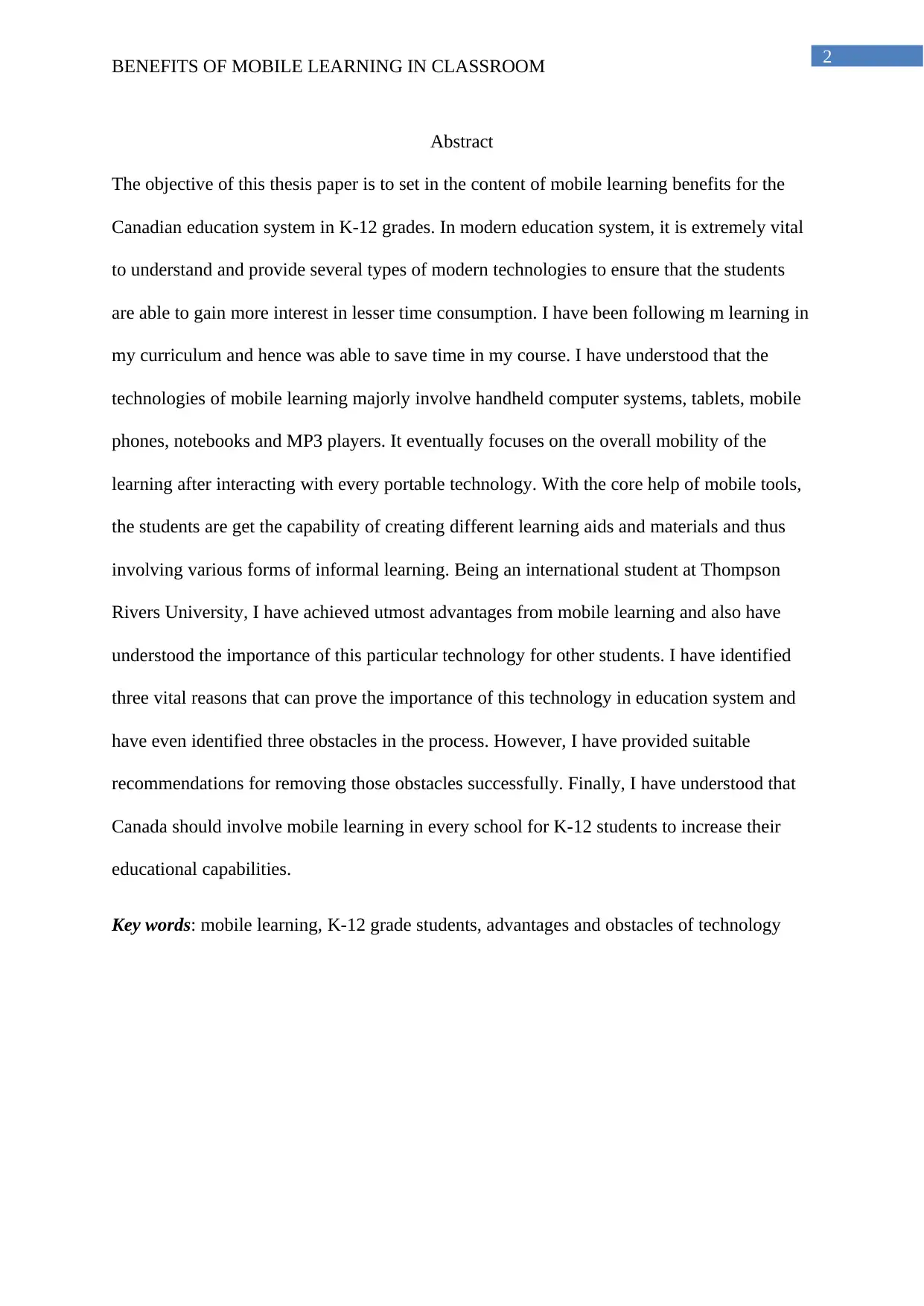
2
BENEFITS OF MOBILE LEARNING IN CLASSROOM
Abstract
The objective of this thesis paper is to set in the content of mobile learning benefits for the
Canadian education system in K-12 grades. In modern education system, it is extremely vital
to understand and provide several types of modern technologies to ensure that the students
are able to gain more interest in lesser time consumption. I have been following m learning in
my curriculum and hence was able to save time in my course. I have understood that the
technologies of mobile learning majorly involve handheld computer systems, tablets, mobile
phones, notebooks and MP3 players. It eventually focuses on the overall mobility of the
learning after interacting with every portable technology. With the core help of mobile tools,
the students are get the capability of creating different learning aids and materials and thus
involving various forms of informal learning. Being an international student at Thompson
Rivers University, I have achieved utmost advantages from mobile learning and also have
understood the importance of this particular technology for other students. I have identified
three vital reasons that can prove the importance of this technology in education system and
have even identified three obstacles in the process. However, I have provided suitable
recommendations for removing those obstacles successfully. Finally, I have understood that
Canada should involve mobile learning in every school for K-12 students to increase their
educational capabilities.
Key words: mobile learning, K-12 grade students, advantages and obstacles of technology
BENEFITS OF MOBILE LEARNING IN CLASSROOM
Abstract
The objective of this thesis paper is to set in the content of mobile learning benefits for the
Canadian education system in K-12 grades. In modern education system, it is extremely vital
to understand and provide several types of modern technologies to ensure that the students
are able to gain more interest in lesser time consumption. I have been following m learning in
my curriculum and hence was able to save time in my course. I have understood that the
technologies of mobile learning majorly involve handheld computer systems, tablets, mobile
phones, notebooks and MP3 players. It eventually focuses on the overall mobility of the
learning after interacting with every portable technology. With the core help of mobile tools,
the students are get the capability of creating different learning aids and materials and thus
involving various forms of informal learning. Being an international student at Thompson
Rivers University, I have achieved utmost advantages from mobile learning and also have
understood the importance of this particular technology for other students. I have identified
three vital reasons that can prove the importance of this technology in education system and
have even identified three obstacles in the process. However, I have provided suitable
recommendations for removing those obstacles successfully. Finally, I have understood that
Canada should involve mobile learning in every school for K-12 students to increase their
educational capabilities.
Key words: mobile learning, K-12 grade students, advantages and obstacles of technology
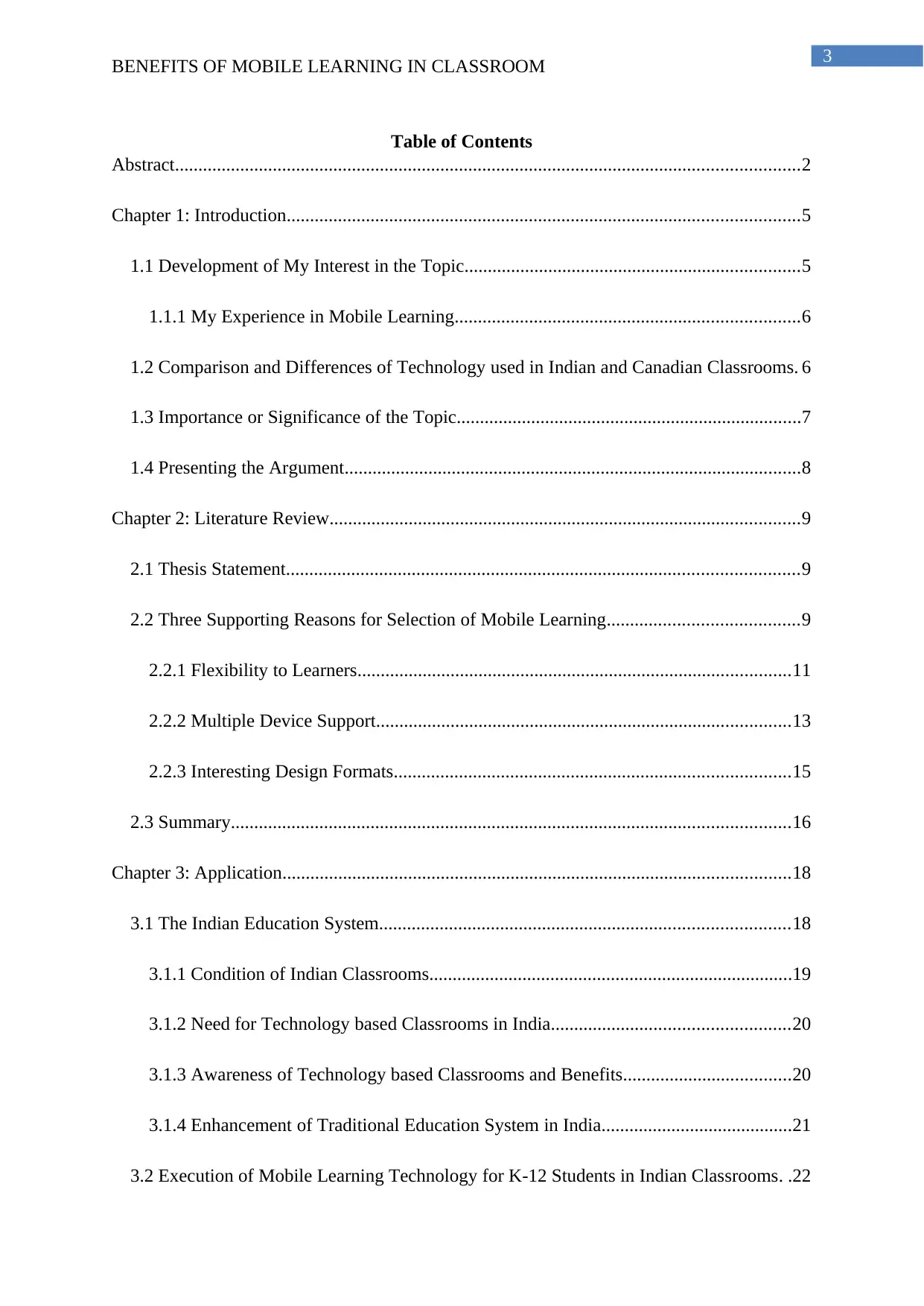
3
BENEFITS OF MOBILE LEARNING IN CLASSROOM
Table of Contents
Abstract......................................................................................................................................2
Chapter 1: Introduction..............................................................................................................5
1.1 Development of My Interest in the Topic........................................................................5
1.1.1 My Experience in Mobile Learning..........................................................................6
1.2 Comparison and Differences of Technology used in Indian and Canadian Classrooms. 6
1.3 Importance or Significance of the Topic..........................................................................7
1.4 Presenting the Argument..................................................................................................8
Chapter 2: Literature Review.....................................................................................................9
2.1 Thesis Statement..............................................................................................................9
2.2 Three Supporting Reasons for Selection of Mobile Learning.........................................9
2.2.1 Flexibility to Learners.............................................................................................11
2.2.2 Multiple Device Support.........................................................................................13
2.2.3 Interesting Design Formats.....................................................................................15
2.3 Summary........................................................................................................................16
Chapter 3: Application.............................................................................................................18
3.1 The Indian Education System........................................................................................18
3.1.1 Condition of Indian Classrooms..............................................................................19
3.1.2 Need for Technology based Classrooms in India...................................................20
3.1.3 Awareness of Technology based Classrooms and Benefits....................................20
3.1.4 Enhancement of Traditional Education System in India.........................................21
3.2 Execution of Mobile Learning Technology for K-12 Students in Indian Classrooms. .22
BENEFITS OF MOBILE LEARNING IN CLASSROOM
Table of Contents
Abstract......................................................................................................................................2
Chapter 1: Introduction..............................................................................................................5
1.1 Development of My Interest in the Topic........................................................................5
1.1.1 My Experience in Mobile Learning..........................................................................6
1.2 Comparison and Differences of Technology used in Indian and Canadian Classrooms. 6
1.3 Importance or Significance of the Topic..........................................................................7
1.4 Presenting the Argument..................................................................................................8
Chapter 2: Literature Review.....................................................................................................9
2.1 Thesis Statement..............................................................................................................9
2.2 Three Supporting Reasons for Selection of Mobile Learning.........................................9
2.2.1 Flexibility to Learners.............................................................................................11
2.2.2 Multiple Device Support.........................................................................................13
2.2.3 Interesting Design Formats.....................................................................................15
2.3 Summary........................................................................................................................16
Chapter 3: Application.............................................................................................................18
3.1 The Indian Education System........................................................................................18
3.1.1 Condition of Indian Classrooms..............................................................................19
3.1.2 Need for Technology based Classrooms in India...................................................20
3.1.3 Awareness of Technology based Classrooms and Benefits....................................20
3.1.4 Enhancement of Traditional Education System in India.........................................21
3.2 Execution of Mobile Learning Technology for K-12 Students in Indian Classrooms. .22
⊘ This is a preview!⊘
Do you want full access?
Subscribe today to unlock all pages.

Trusted by 1+ million students worldwide
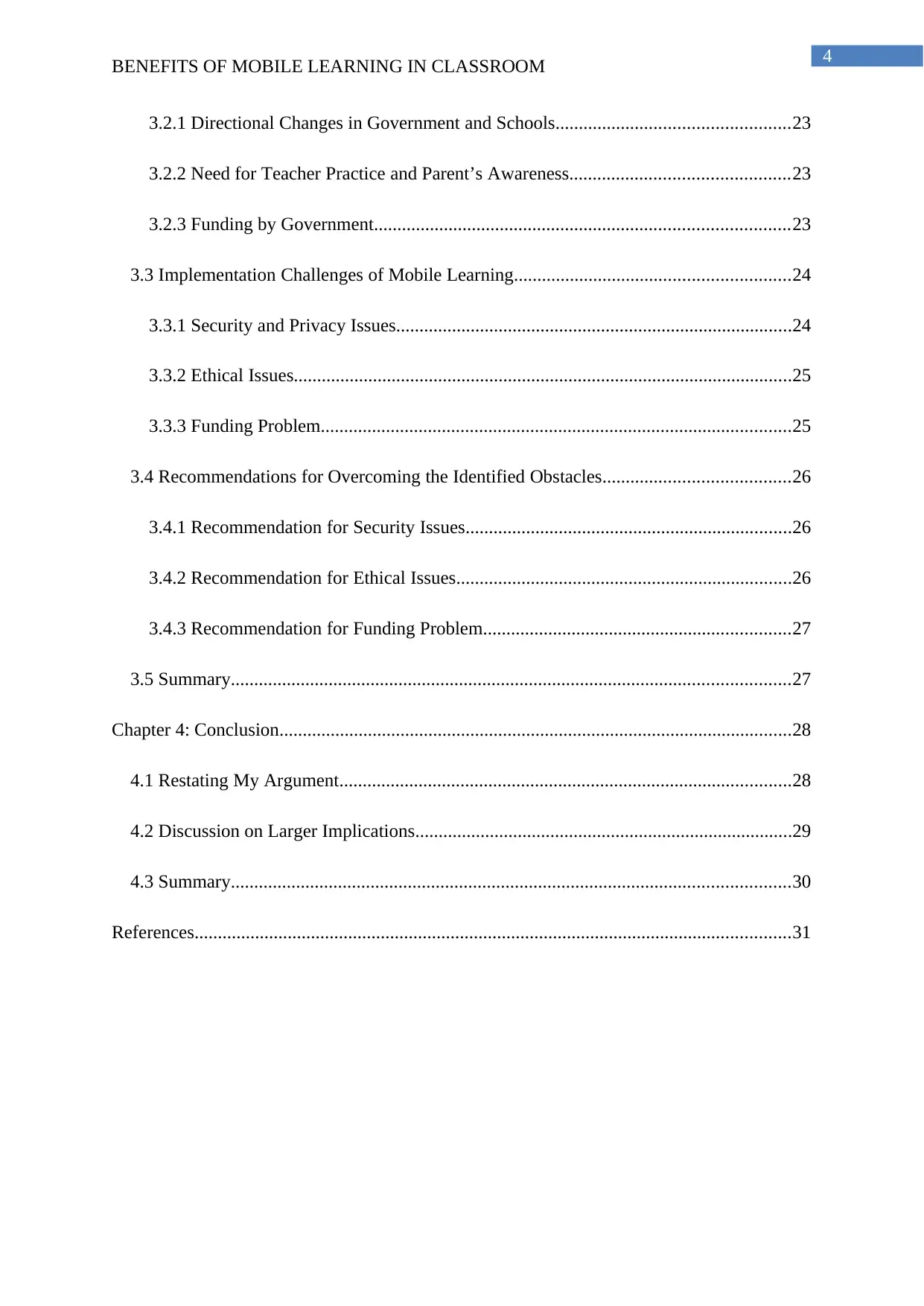
4
BENEFITS OF MOBILE LEARNING IN CLASSROOM
3.2.1 Directional Changes in Government and Schools..................................................23
3.2.2 Need for Teacher Practice and Parent’s Awareness...............................................23
3.2.3 Funding by Government.........................................................................................23
3.3 Implementation Challenges of Mobile Learning...........................................................24
3.3.1 Security and Privacy Issues.....................................................................................24
3.3.2 Ethical Issues...........................................................................................................25
3.3.3 Funding Problem.....................................................................................................25
3.4 Recommendations for Overcoming the Identified Obstacles........................................26
3.4.1 Recommendation for Security Issues......................................................................26
3.4.2 Recommendation for Ethical Issues........................................................................26
3.4.3 Recommendation for Funding Problem..................................................................27
3.5 Summary........................................................................................................................27
Chapter 4: Conclusion..............................................................................................................28
4.1 Restating My Argument.................................................................................................28
4.2 Discussion on Larger Implications.................................................................................29
4.3 Summary........................................................................................................................30
References................................................................................................................................31
BENEFITS OF MOBILE LEARNING IN CLASSROOM
3.2.1 Directional Changes in Government and Schools..................................................23
3.2.2 Need for Teacher Practice and Parent’s Awareness...............................................23
3.2.3 Funding by Government.........................................................................................23
3.3 Implementation Challenges of Mobile Learning...........................................................24
3.3.1 Security and Privacy Issues.....................................................................................24
3.3.2 Ethical Issues...........................................................................................................25
3.3.3 Funding Problem.....................................................................................................25
3.4 Recommendations for Overcoming the Identified Obstacles........................................26
3.4.1 Recommendation for Security Issues......................................................................26
3.4.2 Recommendation for Ethical Issues........................................................................26
3.4.3 Recommendation for Funding Problem..................................................................27
3.5 Summary........................................................................................................................27
Chapter 4: Conclusion..............................................................................................................28
4.1 Restating My Argument.................................................................................................28
4.2 Discussion on Larger Implications.................................................................................29
4.3 Summary........................................................................................................................30
References................................................................................................................................31
Paraphrase This Document
Need a fresh take? Get an instant paraphrase of this document with our AI Paraphraser
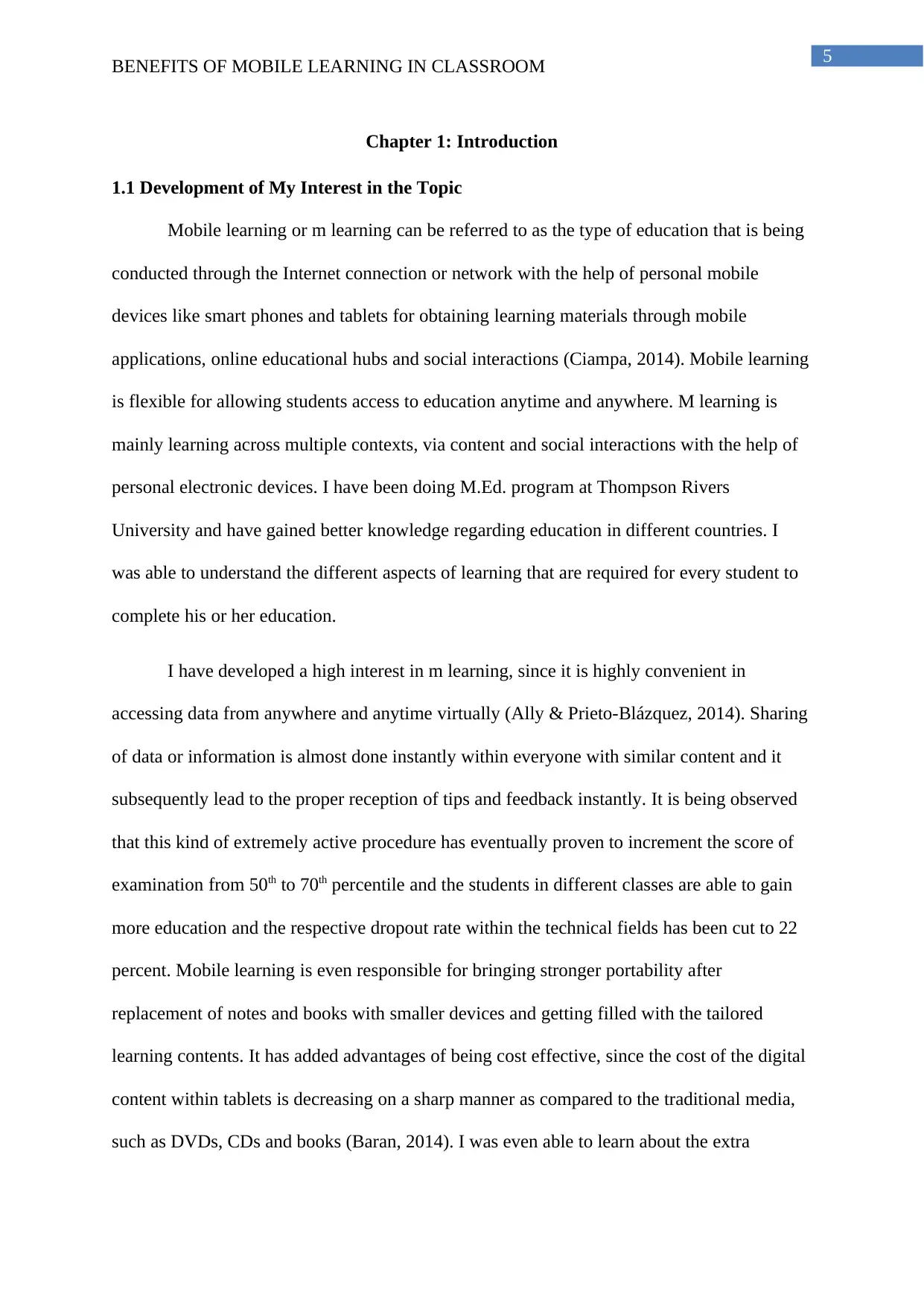
5
BENEFITS OF MOBILE LEARNING IN CLASSROOM
Chapter 1: Introduction
1.1 Development of My Interest in the Topic
Mobile learning or m learning can be referred to as the type of education that is being
conducted through the Internet connection or network with the help of personal mobile
devices like smart phones and tablets for obtaining learning materials through mobile
applications, online educational hubs and social interactions (Ciampa, 2014). Mobile learning
is flexible for allowing students access to education anytime and anywhere. M learning is
mainly learning across multiple contexts, via content and social interactions with the help of
personal electronic devices. I have been doing M.Ed. program at Thompson Rivers
University and have gained better knowledge regarding education in different countries. I
was able to understand the different aspects of learning that are required for every student to
complete his or her education.
I have developed a high interest in m learning, since it is highly convenient in
accessing data from anywhere and anytime virtually (Ally & Prieto-Blázquez, 2014). Sharing
of data or information is almost done instantly within everyone with similar content and it
subsequently lead to the proper reception of tips and feedback instantly. It is being observed
that this kind of extremely active procedure has eventually proven to increment the score of
examination from 50th to 70th percentile and the students in different classes are able to gain
more education and the respective dropout rate within the technical fields has been cut to 22
percent. Mobile learning is even responsible for bringing stronger portability after
replacement of notes and books with smaller devices and getting filled with the tailored
learning contents. It has added advantages of being cost effective, since the cost of the digital
content within tablets is decreasing on a sharp manner as compared to the traditional media,
such as DVDs, CDs and books (Baran, 2014). I was even able to learn about the extra
BENEFITS OF MOBILE LEARNING IN CLASSROOM
Chapter 1: Introduction
1.1 Development of My Interest in the Topic
Mobile learning or m learning can be referred to as the type of education that is being
conducted through the Internet connection or network with the help of personal mobile
devices like smart phones and tablets for obtaining learning materials through mobile
applications, online educational hubs and social interactions (Ciampa, 2014). Mobile learning
is flexible for allowing students access to education anytime and anywhere. M learning is
mainly learning across multiple contexts, via content and social interactions with the help of
personal electronic devices. I have been doing M.Ed. program at Thompson Rivers
University and have gained better knowledge regarding education in different countries. I
was able to understand the different aspects of learning that are required for every student to
complete his or her education.
I have developed a high interest in m learning, since it is highly convenient in
accessing data from anywhere and anytime virtually (Ally & Prieto-Blázquez, 2014). Sharing
of data or information is almost done instantly within everyone with similar content and it
subsequently lead to the proper reception of tips and feedback instantly. It is being observed
that this kind of extremely active procedure has eventually proven to increment the score of
examination from 50th to 70th percentile and the students in different classes are able to gain
more education and the respective dropout rate within the technical fields has been cut to 22
percent. Mobile learning is even responsible for bringing stronger portability after
replacement of notes and books with smaller devices and getting filled with the tailored
learning contents. It has added advantages of being cost effective, since the cost of the digital
content within tablets is decreasing on a sharp manner as compared to the traditional media,
such as DVDs, CDs and books (Baran, 2014). I was even able to learn about the extra
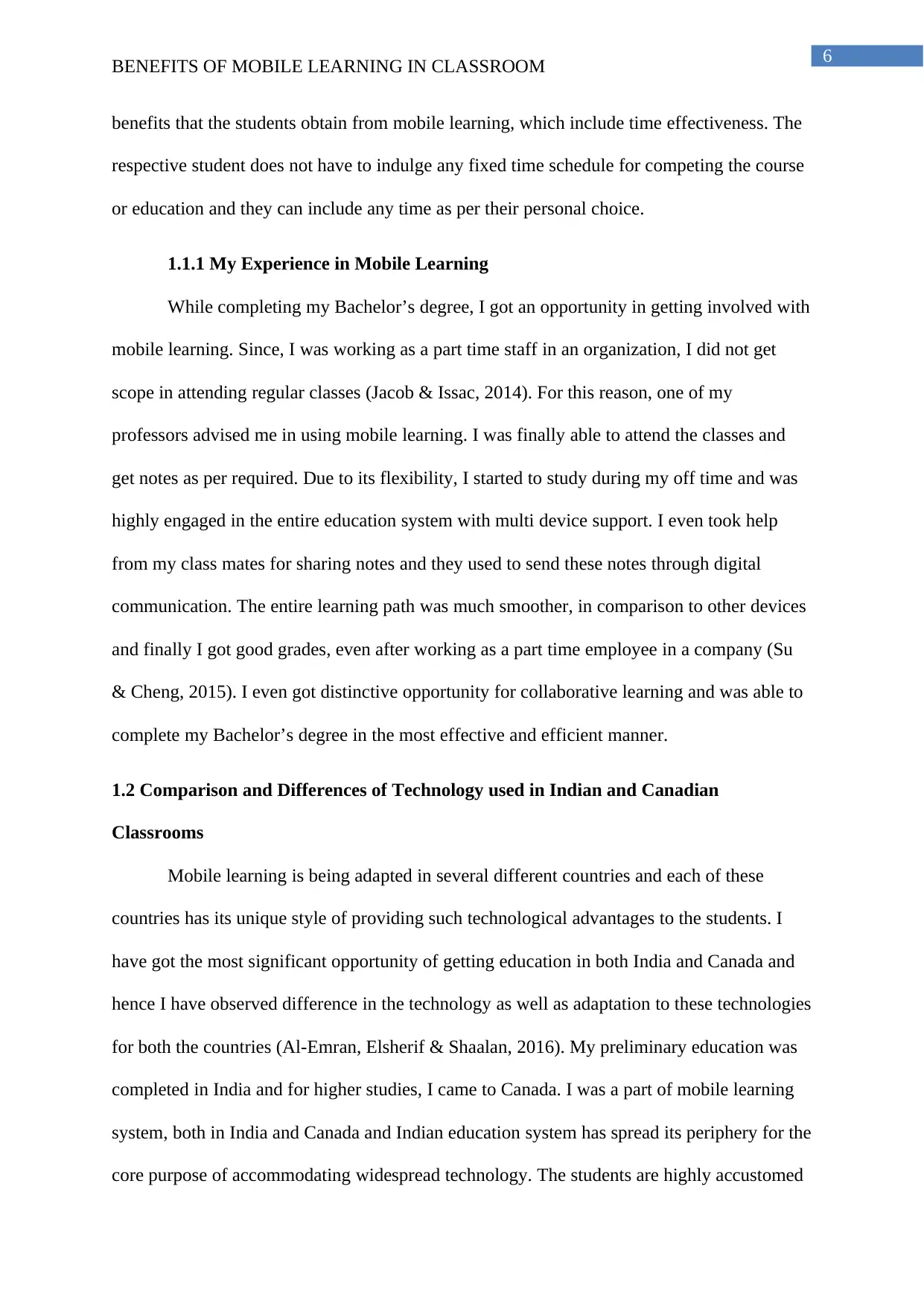
6
BENEFITS OF MOBILE LEARNING IN CLASSROOM
benefits that the students obtain from mobile learning, which include time effectiveness. The
respective student does not have to indulge any fixed time schedule for competing the course
or education and they can include any time as per their personal choice.
1.1.1 My Experience in Mobile Learning
While completing my Bachelor’s degree, I got an opportunity in getting involved with
mobile learning. Since, I was working as a part time staff in an organization, I did not get
scope in attending regular classes (Jacob & Issac, 2014). For this reason, one of my
professors advised me in using mobile learning. I was finally able to attend the classes and
get notes as per required. Due to its flexibility, I started to study during my off time and was
highly engaged in the entire education system with multi device support. I even took help
from my class mates for sharing notes and they used to send these notes through digital
communication. The entire learning path was much smoother, in comparison to other devices
and finally I got good grades, even after working as a part time employee in a company (Su
& Cheng, 2015). I even got distinctive opportunity for collaborative learning and was able to
complete my Bachelor’s degree in the most effective and efficient manner.
1.2 Comparison and Differences of Technology used in Indian and Canadian
Classrooms
Mobile learning is being adapted in several different countries and each of these
countries has its unique style of providing such technological advantages to the students. I
have got the most significant opportunity of getting education in both India and Canada and
hence I have observed difference in the technology as well as adaptation to these technologies
for both the countries (Al-Emran, Elsherif & Shaalan, 2016). My preliminary education was
completed in India and for higher studies, I came to Canada. I was a part of mobile learning
system, both in India and Canada and Indian education system has spread its periphery for the
core purpose of accommodating widespread technology. The students are highly accustomed
BENEFITS OF MOBILE LEARNING IN CLASSROOM
benefits that the students obtain from mobile learning, which include time effectiveness. The
respective student does not have to indulge any fixed time schedule for competing the course
or education and they can include any time as per their personal choice.
1.1.1 My Experience in Mobile Learning
While completing my Bachelor’s degree, I got an opportunity in getting involved with
mobile learning. Since, I was working as a part time staff in an organization, I did not get
scope in attending regular classes (Jacob & Issac, 2014). For this reason, one of my
professors advised me in using mobile learning. I was finally able to attend the classes and
get notes as per required. Due to its flexibility, I started to study during my off time and was
highly engaged in the entire education system with multi device support. I even took help
from my class mates for sharing notes and they used to send these notes through digital
communication. The entire learning path was much smoother, in comparison to other devices
and finally I got good grades, even after working as a part time employee in a company (Su
& Cheng, 2015). I even got distinctive opportunity for collaborative learning and was able to
complete my Bachelor’s degree in the most effective and efficient manner.
1.2 Comparison and Differences of Technology used in Indian and Canadian
Classrooms
Mobile learning is being adapted in several different countries and each of these
countries has its unique style of providing such technological advantages to the students. I
have got the most significant opportunity of getting education in both India and Canada and
hence I have observed difference in the technology as well as adaptation to these technologies
for both the countries (Al-Emran, Elsherif & Shaalan, 2016). My preliminary education was
completed in India and for higher studies, I came to Canada. I was a part of mobile learning
system, both in India and Canada and Indian education system has spread its periphery for the
core purpose of accommodating widespread technology. The students are highly accustomed
⊘ This is a preview!⊘
Do you want full access?
Subscribe today to unlock all pages.

Trusted by 1+ million students worldwide
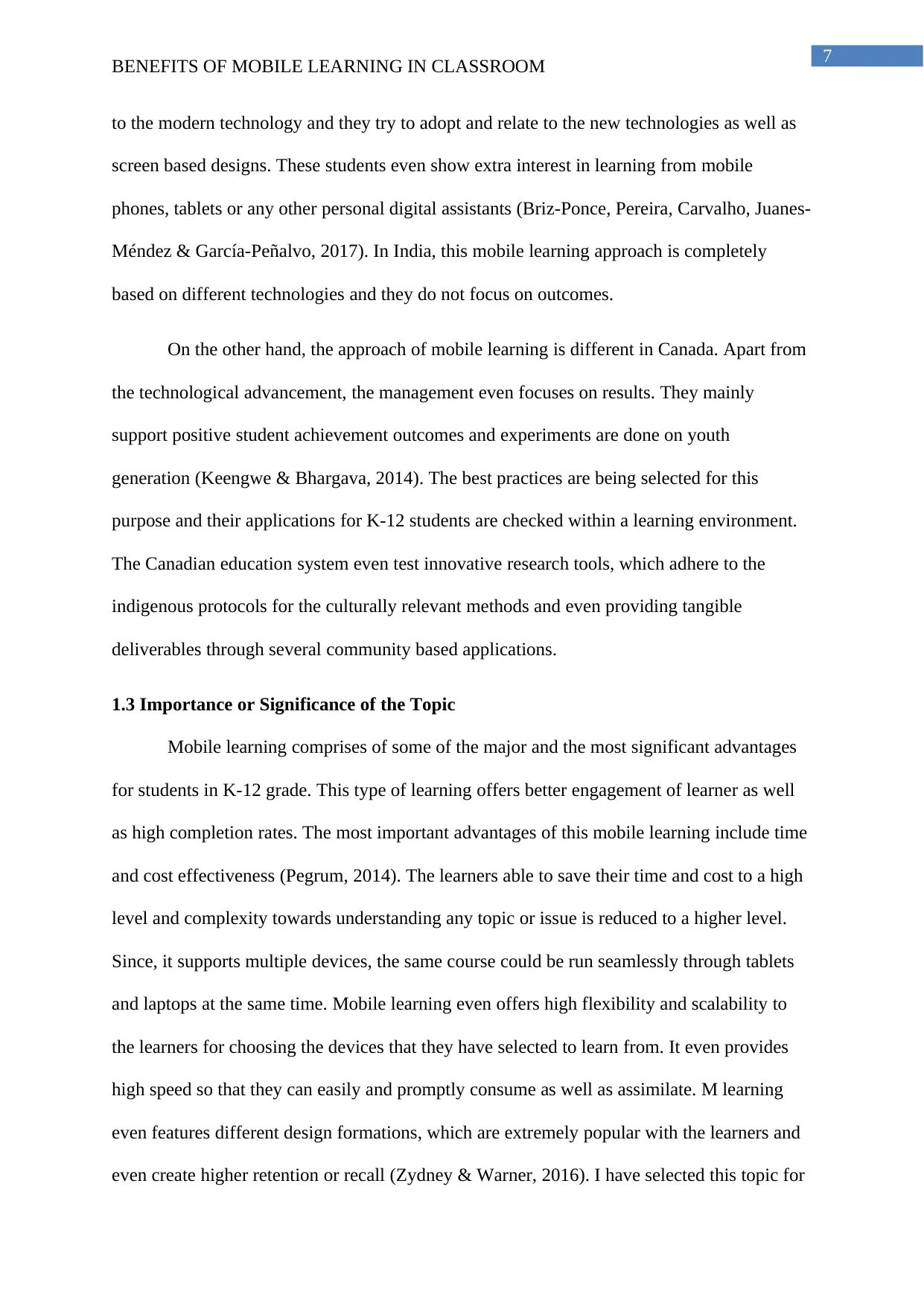
7
BENEFITS OF MOBILE LEARNING IN CLASSROOM
to the modern technology and they try to adopt and relate to the new technologies as well as
screen based designs. These students even show extra interest in learning from mobile
phones, tablets or any other personal digital assistants (Briz-Ponce, Pereira, Carvalho, Juanes-
Méndez & García-Peñalvo, 2017). In India, this mobile learning approach is completely
based on different technologies and they do not focus on outcomes.
On the other hand, the approach of mobile learning is different in Canada. Apart from
the technological advancement, the management even focuses on results. They mainly
support positive student achievement outcomes and experiments are done on youth
generation (Keengwe & Bhargava, 2014). The best practices are being selected for this
purpose and their applications for K-12 students are checked within a learning environment.
The Canadian education system even test innovative research tools, which adhere to the
indigenous protocols for the culturally relevant methods and even providing tangible
deliverables through several community based applications.
1.3 Importance or Significance of the Topic
Mobile learning comprises of some of the major and the most significant advantages
for students in K-12 grade. This type of learning offers better engagement of learner as well
as high completion rates. The most important advantages of this mobile learning include time
and cost effectiveness (Pegrum, 2014). The learners able to save their time and cost to a high
level and complexity towards understanding any topic or issue is reduced to a higher level.
Since, it supports multiple devices, the same course could be run seamlessly through tablets
and laptops at the same time. Mobile learning even offers high flexibility and scalability to
the learners for choosing the devices that they have selected to learn from. It even provides
high speed so that they can easily and promptly consume as well as assimilate. M learning
even features different design formations, which are extremely popular with the learners and
even create higher retention or recall (Zydney & Warner, 2016). I have selected this topic for
BENEFITS OF MOBILE LEARNING IN CLASSROOM
to the modern technology and they try to adopt and relate to the new technologies as well as
screen based designs. These students even show extra interest in learning from mobile
phones, tablets or any other personal digital assistants (Briz-Ponce, Pereira, Carvalho, Juanes-
Méndez & García-Peñalvo, 2017). In India, this mobile learning approach is completely
based on different technologies and they do not focus on outcomes.
On the other hand, the approach of mobile learning is different in Canada. Apart from
the technological advancement, the management even focuses on results. They mainly
support positive student achievement outcomes and experiments are done on youth
generation (Keengwe & Bhargava, 2014). The best practices are being selected for this
purpose and their applications for K-12 students are checked within a learning environment.
The Canadian education system even test innovative research tools, which adhere to the
indigenous protocols for the culturally relevant methods and even providing tangible
deliverables through several community based applications.
1.3 Importance or Significance of the Topic
Mobile learning comprises of some of the major and the most significant advantages
for students in K-12 grade. This type of learning offers better engagement of learner as well
as high completion rates. The most important advantages of this mobile learning include time
and cost effectiveness (Pegrum, 2014). The learners able to save their time and cost to a high
level and complexity towards understanding any topic or issue is reduced to a higher level.
Since, it supports multiple devices, the same course could be run seamlessly through tablets
and laptops at the same time. Mobile learning even offers high flexibility and scalability to
the learners for choosing the devices that they have selected to learn from. It even provides
high speed so that they can easily and promptly consume as well as assimilate. M learning
even features different design formations, which are extremely popular with the learners and
even create higher retention or recall (Zydney & Warner, 2016). I have selected this topic for
Paraphrase This Document
Need a fresh take? Get an instant paraphrase of this document with our AI Paraphraser
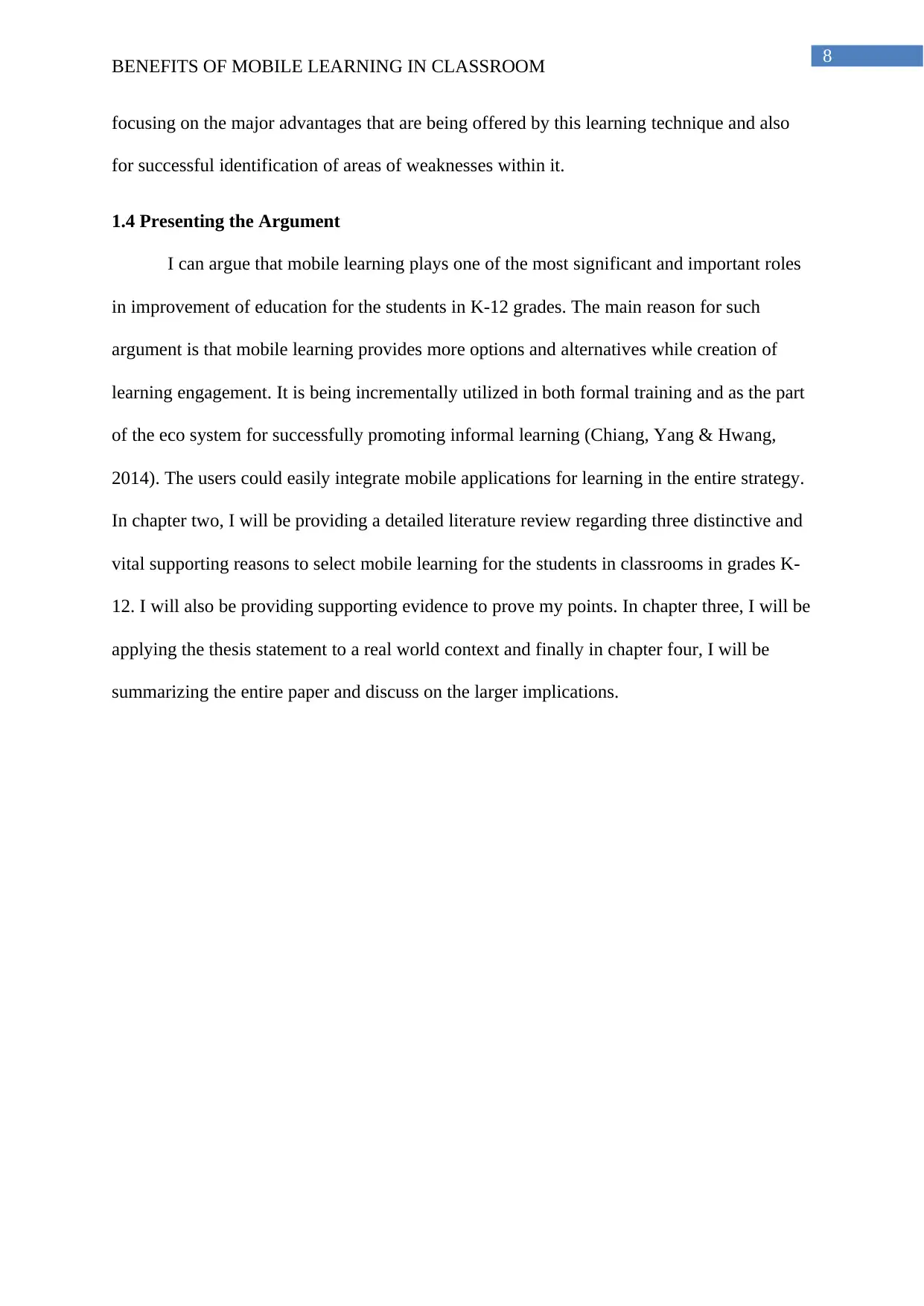
8
BENEFITS OF MOBILE LEARNING IN CLASSROOM
focusing on the major advantages that are being offered by this learning technique and also
for successful identification of areas of weaknesses within it.
1.4 Presenting the Argument
I can argue that mobile learning plays one of the most significant and important roles
in improvement of education for the students in K-12 grades. The main reason for such
argument is that mobile learning provides more options and alternatives while creation of
learning engagement. It is being incrementally utilized in both formal training and as the part
of the eco system for successfully promoting informal learning (Chiang, Yang & Hwang,
2014). The users could easily integrate mobile applications for learning in the entire strategy.
In chapter two, I will be providing a detailed literature review regarding three distinctive and
vital supporting reasons to select mobile learning for the students in classrooms in grades K-
12. I will also be providing supporting evidence to prove my points. In chapter three, I will be
applying the thesis statement to a real world context and finally in chapter four, I will be
summarizing the entire paper and discuss on the larger implications.
BENEFITS OF MOBILE LEARNING IN CLASSROOM
focusing on the major advantages that are being offered by this learning technique and also
for successful identification of areas of weaknesses within it.
1.4 Presenting the Argument
I can argue that mobile learning plays one of the most significant and important roles
in improvement of education for the students in K-12 grades. The main reason for such
argument is that mobile learning provides more options and alternatives while creation of
learning engagement. It is being incrementally utilized in both formal training and as the part
of the eco system for successfully promoting informal learning (Chiang, Yang & Hwang,
2014). The users could easily integrate mobile applications for learning in the entire strategy.
In chapter two, I will be providing a detailed literature review regarding three distinctive and
vital supporting reasons to select mobile learning for the students in classrooms in grades K-
12. I will also be providing supporting evidence to prove my points. In chapter three, I will be
applying the thesis statement to a real world context and finally in chapter four, I will be
summarizing the entire paper and discuss on the larger implications.
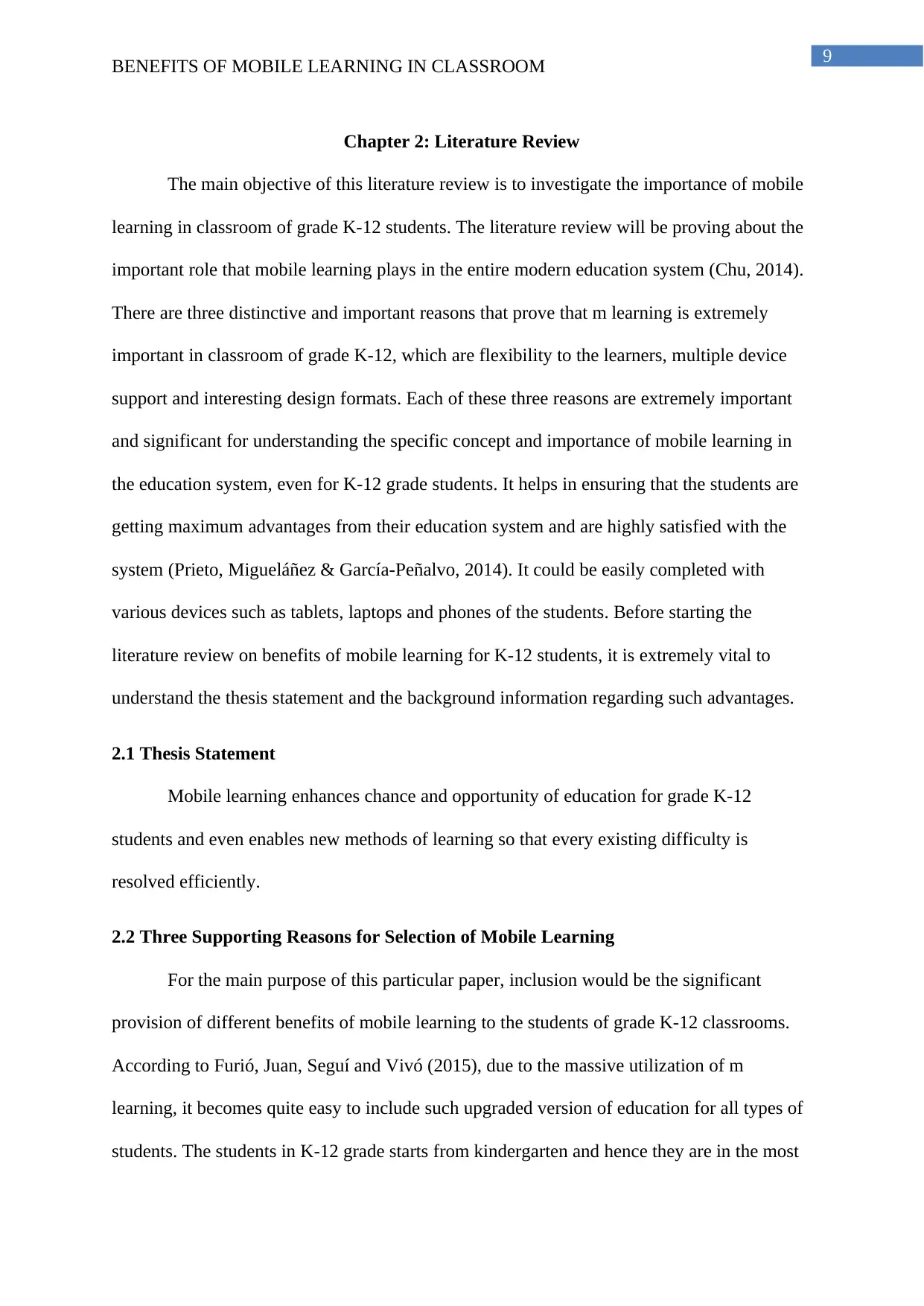
9
BENEFITS OF MOBILE LEARNING IN CLASSROOM
Chapter 2: Literature Review
The main objective of this literature review is to investigate the importance of mobile
learning in classroom of grade K-12 students. The literature review will be proving about the
important role that mobile learning plays in the entire modern education system (Chu, 2014).
There are three distinctive and important reasons that prove that m learning is extremely
important in classroom of grade K-12, which are flexibility to the learners, multiple device
support and interesting design formats. Each of these three reasons are extremely important
and significant for understanding the specific concept and importance of mobile learning in
the education system, even for K-12 grade students. It helps in ensuring that the students are
getting maximum advantages from their education system and are highly satisfied with the
system (Prieto, Migueláñez & García-Peñalvo, 2014). It could be easily completed with
various devices such as tablets, laptops and phones of the students. Before starting the
literature review on benefits of mobile learning for K-12 students, it is extremely vital to
understand the thesis statement and the background information regarding such advantages.
2.1 Thesis Statement
Mobile learning enhances chance and opportunity of education for grade K-12
students and even enables new methods of learning so that every existing difficulty is
resolved efficiently.
2.2 Three Supporting Reasons for Selection of Mobile Learning
For the main purpose of this particular paper, inclusion would be the significant
provision of different benefits of mobile learning to the students of grade K-12 classrooms.
According to Furió, Juan, Seguí and Vivó (2015), due to the massive utilization of m
learning, it becomes quite easy to include such upgraded version of education for all types of
students. The students in K-12 grade starts from kindergarten and hence they are in the most
BENEFITS OF MOBILE LEARNING IN CLASSROOM
Chapter 2: Literature Review
The main objective of this literature review is to investigate the importance of mobile
learning in classroom of grade K-12 students. The literature review will be proving about the
important role that mobile learning plays in the entire modern education system (Chu, 2014).
There are three distinctive and important reasons that prove that m learning is extremely
important in classroom of grade K-12, which are flexibility to the learners, multiple device
support and interesting design formats. Each of these three reasons are extremely important
and significant for understanding the specific concept and importance of mobile learning in
the education system, even for K-12 grade students. It helps in ensuring that the students are
getting maximum advantages from their education system and are highly satisfied with the
system (Prieto, Migueláñez & García-Peñalvo, 2014). It could be easily completed with
various devices such as tablets, laptops and phones of the students. Before starting the
literature review on benefits of mobile learning for K-12 students, it is extremely vital to
understand the thesis statement and the background information regarding such advantages.
2.1 Thesis Statement
Mobile learning enhances chance and opportunity of education for grade K-12
students and even enables new methods of learning so that every existing difficulty is
resolved efficiently.
2.2 Three Supporting Reasons for Selection of Mobile Learning
For the main purpose of this particular paper, inclusion would be the significant
provision of different benefits of mobile learning to the students of grade K-12 classrooms.
According to Furió, Juan, Seguí and Vivó (2015), due to the massive utilization of m
learning, it becomes quite easy to include such upgraded version of education for all types of
students. The students in K-12 grade starts from kindergarten and hence they are in the most
⊘ This is a preview!⊘
Do you want full access?
Subscribe today to unlock all pages.

Trusted by 1+ million students worldwide
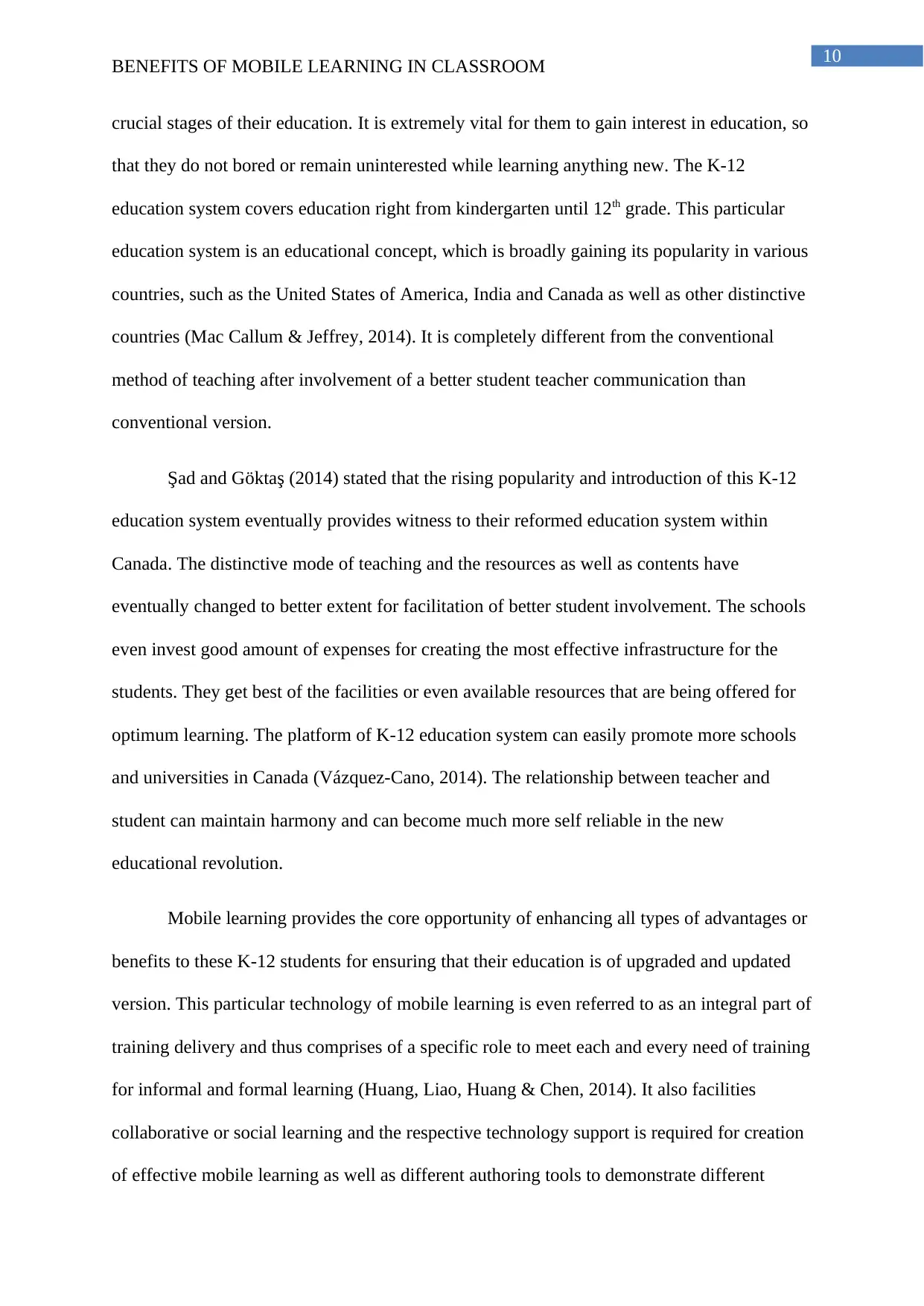
10
BENEFITS OF MOBILE LEARNING IN CLASSROOM
crucial stages of their education. It is extremely vital for them to gain interest in education, so
that they do not bored or remain uninterested while learning anything new. The K-12
education system covers education right from kindergarten until 12th grade. This particular
education system is an educational concept, which is broadly gaining its popularity in various
countries, such as the United States of America, India and Canada as well as other distinctive
countries (Mac Callum & Jeffrey, 2014). It is completely different from the conventional
method of teaching after involvement of a better student teacher communication than
conventional version.
Şad and Göktaş (2014) stated that the rising popularity and introduction of this K-12
education system eventually provides witness to their reformed education system within
Canada. The distinctive mode of teaching and the resources as well as contents have
eventually changed to better extent for facilitation of better student involvement. The schools
even invest good amount of expenses for creating the most effective infrastructure for the
students. They get best of the facilities or even available resources that are being offered for
optimum learning. The platform of K-12 education system can easily promote more schools
and universities in Canada (Vázquez-Cano, 2014). The relationship between teacher and
student can maintain harmony and can become much more self reliable in the new
educational revolution.
Mobile learning provides the core opportunity of enhancing all types of advantages or
benefits to these K-12 students for ensuring that their education is of upgraded and updated
version. This particular technology of mobile learning is even referred to as an integral part of
training delivery and thus comprises of a specific role to meet each and every need of training
for informal and formal learning (Huang, Liao, Huang & Chen, 2014). It also facilities
collaborative or social learning and the respective technology support is required for creation
of effective mobile learning as well as different authoring tools to demonstrate different
BENEFITS OF MOBILE LEARNING IN CLASSROOM
crucial stages of their education. It is extremely vital for them to gain interest in education, so
that they do not bored or remain uninterested while learning anything new. The K-12
education system covers education right from kindergarten until 12th grade. This particular
education system is an educational concept, which is broadly gaining its popularity in various
countries, such as the United States of America, India and Canada as well as other distinctive
countries (Mac Callum & Jeffrey, 2014). It is completely different from the conventional
method of teaching after involvement of a better student teacher communication than
conventional version.
Şad and Göktaş (2014) stated that the rising popularity and introduction of this K-12
education system eventually provides witness to their reformed education system within
Canada. The distinctive mode of teaching and the resources as well as contents have
eventually changed to better extent for facilitation of better student involvement. The schools
even invest good amount of expenses for creating the most effective infrastructure for the
students. They get best of the facilities or even available resources that are being offered for
optimum learning. The platform of K-12 education system can easily promote more schools
and universities in Canada (Vázquez-Cano, 2014). The relationship between teacher and
student can maintain harmony and can become much more self reliable in the new
educational revolution.
Mobile learning provides the core opportunity of enhancing all types of advantages or
benefits to these K-12 students for ensuring that their education is of upgraded and updated
version. This particular technology of mobile learning is even referred to as an integral part of
training delivery and thus comprises of a specific role to meet each and every need of training
for informal and formal learning (Huang, Liao, Huang & Chen, 2014). It also facilities
collaborative or social learning and the respective technology support is required for creation
of effective mobile learning as well as different authoring tools to demonstrate different
Paraphrase This Document
Need a fresh take? Get an instant paraphrase of this document with our AI Paraphraser
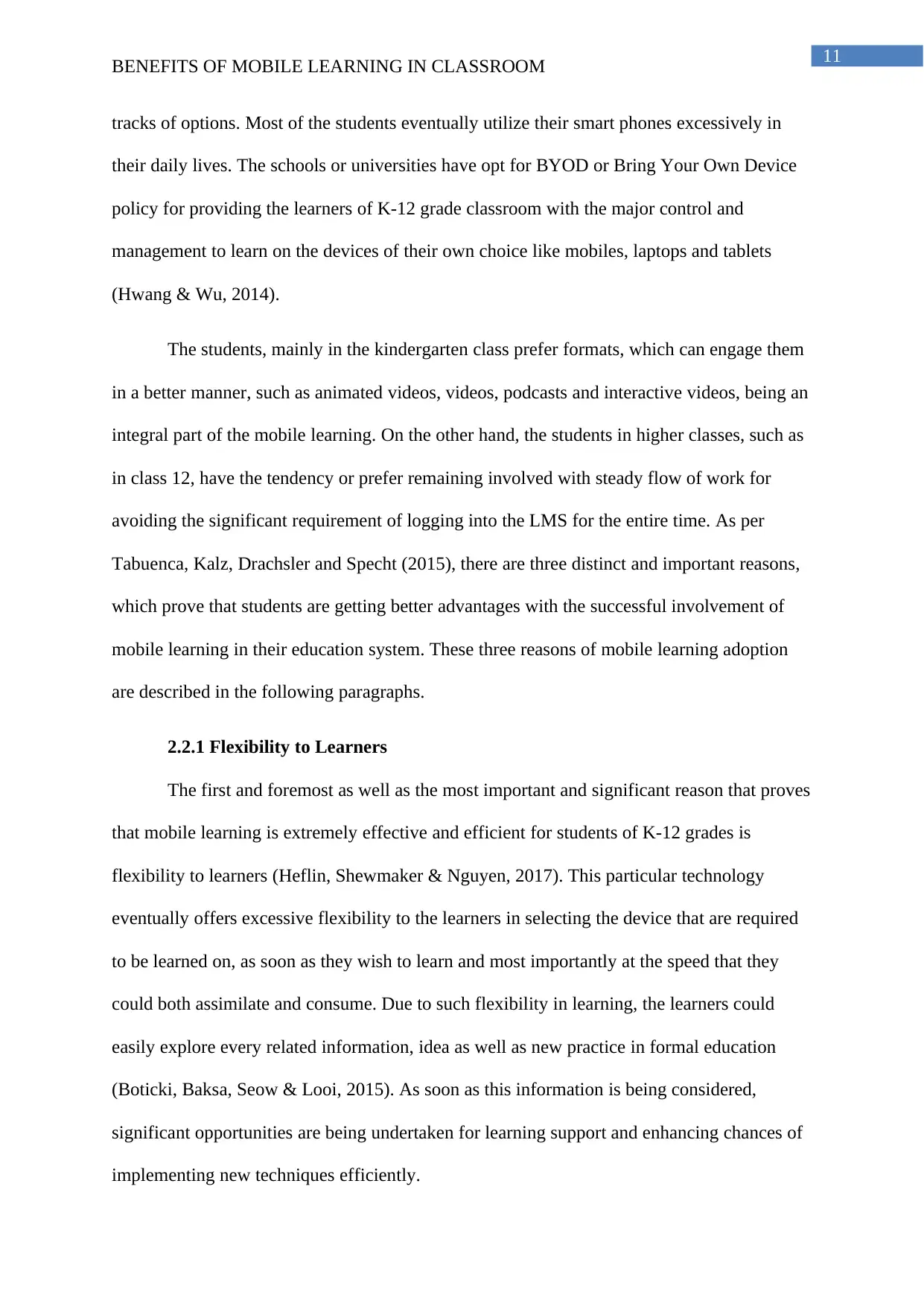
11
BENEFITS OF MOBILE LEARNING IN CLASSROOM
tracks of options. Most of the students eventually utilize their smart phones excessively in
their daily lives. The schools or universities have opt for BYOD or Bring Your Own Device
policy for providing the learners of K-12 grade classroom with the major control and
management to learn on the devices of their own choice like mobiles, laptops and tablets
(Hwang & Wu, 2014).
The students, mainly in the kindergarten class prefer formats, which can engage them
in a better manner, such as animated videos, videos, podcasts and interactive videos, being an
integral part of the mobile learning. On the other hand, the students in higher classes, such as
in class 12, have the tendency or prefer remaining involved with steady flow of work for
avoiding the significant requirement of logging into the LMS for the entire time. As per
Tabuenca, Kalz, Drachsler and Specht (2015), there are three distinct and important reasons,
which prove that students are getting better advantages with the successful involvement of
mobile learning in their education system. These three reasons of mobile learning adoption
are described in the following paragraphs.
2.2.1 Flexibility to Learners
The first and foremost as well as the most important and significant reason that proves
that mobile learning is extremely effective and efficient for students of K-12 grades is
flexibility to learners (Heflin, Shewmaker & Nguyen, 2017). This particular technology
eventually offers excessive flexibility to the learners in selecting the device that are required
to be learned on, as soon as they wish to learn and most importantly at the speed that they
could both assimilate and consume. Due to such flexibility in learning, the learners could
easily explore every related information, idea as well as new practice in formal education
(Boticki, Baksa, Seow & Looi, 2015). As soon as this information is being considered,
significant opportunities are being undertaken for learning support and enhancing chances of
implementing new techniques efficiently.
BENEFITS OF MOBILE LEARNING IN CLASSROOM
tracks of options. Most of the students eventually utilize their smart phones excessively in
their daily lives. The schools or universities have opt for BYOD or Bring Your Own Device
policy for providing the learners of K-12 grade classroom with the major control and
management to learn on the devices of their own choice like mobiles, laptops and tablets
(Hwang & Wu, 2014).
The students, mainly in the kindergarten class prefer formats, which can engage them
in a better manner, such as animated videos, videos, podcasts and interactive videos, being an
integral part of the mobile learning. On the other hand, the students in higher classes, such as
in class 12, have the tendency or prefer remaining involved with steady flow of work for
avoiding the significant requirement of logging into the LMS for the entire time. As per
Tabuenca, Kalz, Drachsler and Specht (2015), there are three distinct and important reasons,
which prove that students are getting better advantages with the successful involvement of
mobile learning in their education system. These three reasons of mobile learning adoption
are described in the following paragraphs.
2.2.1 Flexibility to Learners
The first and foremost as well as the most important and significant reason that proves
that mobile learning is extremely effective and efficient for students of K-12 grades is
flexibility to learners (Heflin, Shewmaker & Nguyen, 2017). This particular technology
eventually offers excessive flexibility to the learners in selecting the device that are required
to be learned on, as soon as they wish to learn and most importantly at the speed that they
could both assimilate and consume. Due to such flexibility in learning, the learners could
easily explore every related information, idea as well as new practice in formal education
(Boticki, Baksa, Seow & Looi, 2015). As soon as this information is being considered,
significant opportunities are being undertaken for learning support and enhancing chances of
implementing new techniques efficiently.
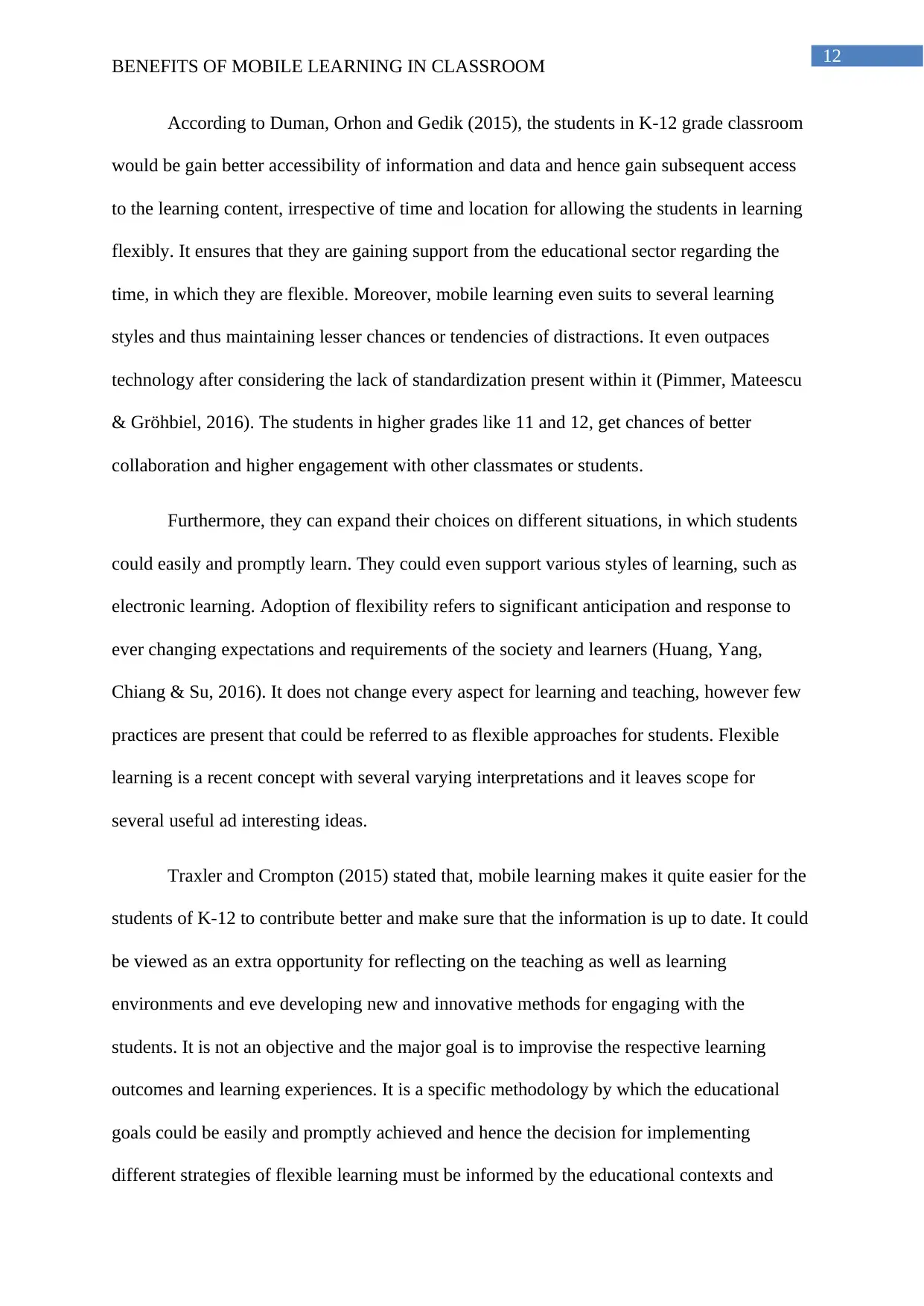
12
BENEFITS OF MOBILE LEARNING IN CLASSROOM
According to Duman, Orhon and Gedik (2015), the students in K-12 grade classroom
would be gain better accessibility of information and data and hence gain subsequent access
to the learning content, irrespective of time and location for allowing the students in learning
flexibly. It ensures that they are gaining support from the educational sector regarding the
time, in which they are flexible. Moreover, mobile learning even suits to several learning
styles and thus maintaining lesser chances or tendencies of distractions. It even outpaces
technology after considering the lack of standardization present within it (Pimmer, Mateescu
& Gröhbiel, 2016). The students in higher grades like 11 and 12, get chances of better
collaboration and higher engagement with other classmates or students.
Furthermore, they can expand their choices on different situations, in which students
could easily and promptly learn. They could even support various styles of learning, such as
electronic learning. Adoption of flexibility refers to significant anticipation and response to
ever changing expectations and requirements of the society and learners (Huang, Yang,
Chiang & Su, 2016). It does not change every aspect for learning and teaching, however few
practices are present that could be referred to as flexible approaches for students. Flexible
learning is a recent concept with several varying interpretations and it leaves scope for
several useful ad interesting ideas.
Traxler and Crompton (2015) stated that, mobile learning makes it quite easier for the
students of K-12 to contribute better and make sure that the information is up to date. It could
be viewed as an extra opportunity for reflecting on the teaching as well as learning
environments and eve developing new and innovative methods for engaging with the
students. It is not an objective and the major goal is to improvise the respective learning
outcomes and learning experiences. It is a specific methodology by which the educational
goals could be easily and promptly achieved and hence the decision for implementing
different strategies of flexible learning must be informed by the educational contexts and
BENEFITS OF MOBILE LEARNING IN CLASSROOM
According to Duman, Orhon and Gedik (2015), the students in K-12 grade classroom
would be gain better accessibility of information and data and hence gain subsequent access
to the learning content, irrespective of time and location for allowing the students in learning
flexibly. It ensures that they are gaining support from the educational sector regarding the
time, in which they are flexible. Moreover, mobile learning even suits to several learning
styles and thus maintaining lesser chances or tendencies of distractions. It even outpaces
technology after considering the lack of standardization present within it (Pimmer, Mateescu
& Gröhbiel, 2016). The students in higher grades like 11 and 12, get chances of better
collaboration and higher engagement with other classmates or students.
Furthermore, they can expand their choices on different situations, in which students
could easily and promptly learn. They could even support various styles of learning, such as
electronic learning. Adoption of flexibility refers to significant anticipation and response to
ever changing expectations and requirements of the society and learners (Huang, Yang,
Chiang & Su, 2016). It does not change every aspect for learning and teaching, however few
practices are present that could be referred to as flexible approaches for students. Flexible
learning is a recent concept with several varying interpretations and it leaves scope for
several useful ad interesting ideas.
Traxler and Crompton (2015) stated that, mobile learning makes it quite easier for the
students of K-12 to contribute better and make sure that the information is up to date. It could
be viewed as an extra opportunity for reflecting on the teaching as well as learning
environments and eve developing new and innovative methods for engaging with the
students. It is not an objective and the major goal is to improvise the respective learning
outcomes and learning experiences. It is a specific methodology by which the educational
goals could be easily and promptly achieved and hence the decision for implementing
different strategies of flexible learning must be informed by the educational contexts and
⊘ This is a preview!⊘
Do you want full access?
Subscribe today to unlock all pages.

Trusted by 1+ million students worldwide
1 out of 34
Related Documents
Your All-in-One AI-Powered Toolkit for Academic Success.
+13062052269
info@desklib.com
Available 24*7 on WhatsApp / Email
![[object Object]](/_next/static/media/star-bottom.7253800d.svg)
Unlock your academic potential
Copyright © 2020–2025 A2Z Services. All Rights Reserved. Developed and managed by ZUCOL.





